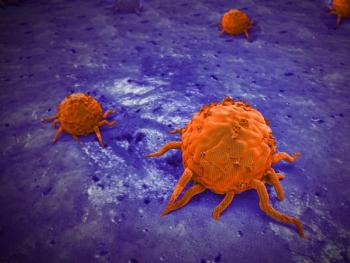
Blinatumomab/Chemo Combo Shows Improved Survival In B-Cell Precursor ALL
An overall survival and 3-year relapse-free survival advantage was seen with blinatumomab vs chemotherapy alone in a phase 3 trial of B-cell precursor subtype ALL.
Blinatumomab (Blincyto) in combination with chemotherapy may increase survival vs chemotherapy alone in patients with the B-cell precursor subtype of acute lymphoblastic leukemia (BCP-ALL) in remission with no trace of cancer, according to results of a phase 3 trial (NCT02003222) that were published in The New England Journal of Medicine.1
Findings showed that, at a median follow-up of 43 months, the HR for overall survival was 0.41 (95% CI, 0.23-0.73; P = .002), with 3-year OS rates of 85% vs 68% for blinatumomab and chemotherapy, respectively. The HR for RFS was 0.53 (95% CI, 0.32-0.87) and the 3-year RFS rates were 80% vs 64%, respectively. Additionally, there was a higher incidence of neuropsychiatric in the experimental group vs the chemotherapy-alone group.
"These results are encouraging and establish a new standard of treatment for people with BCP-ALL," lead study author Mark Litzow, MD, hematologist at Mayo Clinic Comprehensive Cancer Center, stated in a news release.2 "The addition of blinatumomab to chemotherapy reduced the risk of leukemia recurrence and death by nearly 60%."
Investigators enrolled 488 patients between the ages of 30 to 70 years and randomized them to receive either consolidation chemotherapy or blinatumomab with chemotherapy between December 2013 and October 2019. Stratification factors were age, CD20 status, use of rituximab (Rituxan), and intention of transplantation. Additionally, patients with minimal residual disease (MRD)-positive status underwent separate randomization in the initial trial design.
A total 224 patients with MRD-negative status who were randomized to the experimental (n = 112) or chemotherapy group (n = 112) were included in the final analysis. Additionally, for patients with MRD-positive status (n = 62), 44 patients were 1:1 randomized between the 2 arms; an additional 18 patients were assigned to the blinatumomab group following protocol amendment.
Blinatumomab was administered as a continuous infusion of 28 µg daily for 28 days across 2 cycles, with 2-week intervals between cycles. This was followed by 4 cycles of consolidation chemotherapy and 2 additional blinatumomab cycles. The chemotherapy-alone group received the same 4 consolidation chemotherapy cycles. Maintenance chemotherapy was given in both arms.
The primary end point of the study was OS for MRD-negative patients; secondary end points included RFS and safety.
Seventeen patients died in the blinatumomab group vs 40 in the chemotherapy-only group. Additional data showed that, in patients younger than 55 years, there was a significantly higher advantage with blinatumomab vs chemotherapy (HR, 0.16; 95% CI, 0.05-0.47). In patients 55 years and older, the HR for OS was 0.66 (95% CI, 0.33-1.35).
The OS benefit was seen across other prespecified subgroups, including those with unfavorable combined molecular risk (HR, 0.39; 95% CI, 0.19-0.78), those with BCR::ABL1-like genotype (HR, 0.28; 95% CI, 0.06-1.36), and those with CD20 positivty (HR, 0.43; 95% CI, 0.18-1.04). Furthermore, benefit was observed in those intended for transplantat (HR, 0.40; 95% CI, 0.15-1.05) and those who used rituximab (HR, 0.38; 95% CI, 0.14-1.06).
Regarding safety, grade 3 adverse events (AEs) occurring in at least 10% of MRD-negative patients in the blinatumomab or chemotherapy-alone arms were anemia (20% vs 35%, respectively), thrombocytopenia (9% vs10%), and febrile neutropenia (16% vs 21%). Additionally, grade 4 AEs occurring in at least 10% of patients in the respective arms were leukopenia (27% vs 52%), neutropenia (55% vs 86%), lymphopenia (8% vs 17%), and thrombocytopenia (40% vs 59%). There was 1 case of treatment-related sepsis in each arm that led to death.
"We plan to build on this study to reduce the amount of chemotherapy people need to receive, ultimately leading to fewer side effects from the treatment and improving overall survival rates," Litzow added in the news release.2
References
- Litzlow MR, Sun Z, Mattison RJ, et al. Blinatumomab for MRD-negative acute lymphoblastic leukemia in adults. N Engl J Med. 2024;391(4):320-333. doi:10.1056/NEJMoa2312948
- New research discovers a new combination of therapy for people with a type of leukemia, leading them to live longer. News release. Mayo Clinic. July 24, 2024. Accessed August 2, 2024. https://tinyurl.com/5db38hy3
Newsletter
Stay up to date on recent advances in the multidisciplinary approach to cancer.



















































































